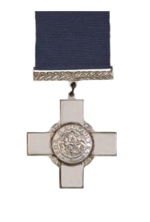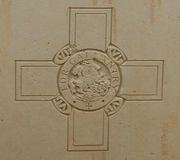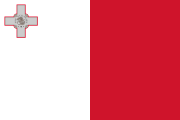George Cross
| George Cross | |
|---|---|
 Obverse of the cross. Ribbon: 38 mm, dark blue. |
|
| Awarded by Commonwealth Realms | |
| Type | Civil decoration. |
| Eligibility | Commonwealth subjects. |
| Awarded for | "... acts of the greatest heroism or of the most conspicuous courage in circumstances of extreme danger." |
| Status | Currently awarded. |
| Description | Height 48 mm, max. width 45 mm; (Obverse) plain silver cross with circular medallion in the centre depicting the effigy of St. George and the Dragon, surrounded by the words "FOR GALLANTRY". In the angle of each limb is the Royal Cypher GVI; (Reverse) plain, centre engraved with name of recipient and date of award. Cross attached by ring to bar ornamented with laurel leaves, through which the ribbon passes. |
| Post-nominals | GC |
| Statistics | |
| Established | 24 September 1940 |
| Total awarded | 161 (including 2 collective awards) |
| Posthumous awards |
86 |
| Distinct recipients |
161 (including 2 collective awards) |
| Precedence | |
| Next (higher) | None |
| Equivalent | Victoria Cross |
| Next (lower) | George Medal |
GC ribbon bar |
|
The George Cross (GC) is the highest civil decoration of the United Kingdom, and also holds, or has held, that status in many of the other countries of the Commonwealth of Nations.[1] The GC is the civilian counterpart of the Victoria Cross (VC) and the highest gallantry award for civilians as well as for military personnel in actions which are not in the face of the enemy or for which purely military honours would not normally be granted.[2] However, the VC is higher in the order of wear and would be worn first by an individual who had been awarded both decorations (which has not so far occurred).[3]
Contents |
Creation
The GC was instituted on 24 September 1940 by King George VI.[4] At this time, during the height of the Blitz, there was a strong desire to reward the many acts of civilian courage. The existing awards open to civilians were not judged suitable to meet the new situation, therefore it was decided that the George Cross and the George Medal would be instituted to recognise both civilian gallantry in the face of enemy action and brave deeds more generally.
Announcing the new award, the King said: "In order that they should be worthily and promptly recognised, I have decided to create, at once, a new mark of honour for men and women in all walks of civilian life. I propose to give my name to this new distinction, which will consist of the George Cross, which will rank next to the Victoria Cross, and the George Medal for wider distribution."[5]
The medal was designed by Percy Metcalfe. The Warrant for the GC (along with that of the GM), dated 24 January 1941, was published in the London Gazette on 31 January 1941.[6]
The GC was intended to replace the Empire Gallantry Medal (EGM); all holders of the EGM were instructed to exchange their medals for a GC, a substitution of awards unprecedented in the history of British decorations. This substitution policy ignored holders of the Albert Medal (AM) and the Edward Medal (EM), awards which both took precedence over the EGM.[7] The anomaly was only rectified in 1971, when the surviving recipients of the AM and the EM were invited to exchange their award for the George Cross. Of the 64 holders of the Albert Medal and 68 holders of the Edward Medal eligible to exchange, 49 and 59 respectively took up the option.[8]
Award
The George Cross, which may be awarded posthumously, is granted in recognition of "acts of the greatest heroism or of the most conspicuous courage in circumstances of extreme danger."[9]
The cross is primarily a civilian award; however the George Cross may be awarded to military personnel for gallant conduct which is not in the face of the enemy.[10] As the Warrant states:
The Cross is intended primarily for civilians and award in Our military services is to be confined to actions for which purely military Honours are not normally granted.[11]
Bars are awarded to the GC in recognition of the performance of further acts of bravery meriting the award, although none have yet been awarded. Recipients are entitled to the postnominal letters GC.[12] In common with the Victoria Cross, a distinction peculiar to these two premier awards for bravery, in undress uniform or on occasions when the medal ribbon alone is worn, a miniature replica of the cross is affixed to the centre of the ribbon.[13]
The details of all awards are published in the London Gazette with the exception of the two collective bestowals.
Recipients
Since its inception in 1940, the GC has been awarded posthumously to 87 recipients and to 74 living people (excluding the two collective awards to Malta and the Royal Ulster Constabulary); including those who were originally awarded other medals, the total number of recipients is 406.[8][14]
Recent recipients

The Ministry of Defence announced on 18 March 2010 that Staff Sergeant Olaf Schmid was posthumously awarded the George Cross for making safe 70 improvised explosive devices in his time in Afghanistan. Staff Sergeant Kim Hughes was also awarded the George Cross for improvised explosive disposal efforts. Two other soldiers have been awarded the George Cross for actions carried out in the conflict in Afghanistan.
- L/Cpl Matthew Croucher of the Royal Marines Reserve was awarded the George Cross for smothering a grenade explosion with his body and equipment on an operation in Afghanistan. Croucher was the first reservist to receive either a VC or GC since current operations in Iraq and Afghanistan began.[15][16]
- Mark Wright, of the 3rd Battalion, the Parachute Regiment, was posthumously awarded the George Cross for entering a minefield in an attempt to save the lives of other injured soldiers. He maintained the morale of the other wounded soldiers, despite his serious injuries, but died of his wounds during the flight to the field dressing station.[17]
The Iraq conflict saw two military recipients of the George Cross, Peter Norton and Christopher Finney.
- Norton was an Ammunition Technical Officer of the Royal Logistic Corps and the GC was awarded for gallantry on 24 July 2005 when he led a bomb disposal team at the site of an IED attack on a US military patrol in Iraq, sustaining serious injuries.[18]
- Trooper Christopher Finney of the Blues and Royals was awarded the George Cross on 31 October 2003 for gallantry during a friendly fire incident in the 2003 invasion of Iraq.[19] Finney is also the youngest military recipient of the decoration.
The most recent civilian recipient was Sergeant Stewart Guthrie of the New Zealand Police, who received his award posthumously for his part in apprehending a gunman in the 1990 Aramoana massacre in New Zealand.[20]
Female recipients
In its history, the GC has been awarded directly to only four women (although a number of others have received the awards superseded by the GC):
- Odette Sansom,[21] (FANY), Violette Szabo,[22] (ATS), and Noor Inayat Khan,[23] (WAAF) (in WWII)
- Barbara Jane Harrison, an air stewardess on a BOAC flight at Heathrow Airport, who died on 8 April 1968 after helping many passengers escape from an onboard fire.[24]
Collective awards

The George Cross has, on the express instruction of the Sovereign, been awarded twice on a collective basis,[25] to the island of Malta and the Royal Ulster Constabulary (RUC).
Malta
The GC was awarded to the island of Malta in a letter dated 15 April 1942 from King George VI to the island's Governor Lieutenant-General Sir William Dobbie:
To honour her brave people, I award the George Cross to the Island Fortress of Malta to bear witness to a heroism and devotion that will long be famous in history.
The Governor answered:
By God's help Malta will not weaken but will endure until victory is won.
The cross and the messages are today found in the War Museum in Fort Saint Elmo, Valletta. The fortitude of the population under sustained enemy air raids and a naval blockade which almost saw them starved into submission, won widespread admiration in Britain and other Allied nations. Some historians argue that the award was in fact a propaganda gesture to justify the huge losses sustained by Britain to prevent Malta from capitulating as Singapore had done in the Battle of Singapore.[26]
The George Cross is woven into the Flag of Malta and can be seen wherever the flag is flown.
Royal Ulster Constabulary
The GC was awarded to the RUC in 1999 by Queen Elizabeth II following the advice of her Government. Buckingham Palace announced,
The Queen has awarded the George Cross to the Royal Ulster Constabulary, to honour the courage and dedication of the officers of the Royal Ulster Constabulary and their families who have shared their hardships.
The Queen paid her own personal tribute to the RUC by presenting the George Cross to the organisation in person at Hillsborough Castle, County Down.
The citation published in the London Gazette on 23 November 1999 states:
For the past 30 years, the Royal Ulster Constabulary has been the bulwark against, and the main target of, a sustained and brutal terrorism campaign. The Force has suffered heavily in protecting both sides of the community from danger—302 officers have been killed in the line of duty and thousands more injured, many seriously. Many officers have been ostracised by their own community and others have been forced to leave their homes in the face of threats to them and their families. As Northern Ireland reaches a turning point in its political development this award is made to recognise the collective courage and dedication to duty of all of those who have served in the Royal Ulster Constabulary and who have accepted the danger and stress this has brought to them and to their families.
Two years later (on 4 November 2001), the RUC was renamed and is now the Police Service of Northern Ireland.
Awards by nation
There have been 10 GCs awarded to Canadians (including those by substitution for awards superseded by the GC): nine men and one woman. The GC is no longer awarded to Canadians by the Queen of Canada, who awards the Cross of Valour (Canadian) instead.
Australia
14 George Crosses were awarded to Australians between 1940 and 1978, five of this total going to civilians. Of the 14, four awards were made to officers of the Royal Australian Naval Volunteer Reserve who served in the extremely dangerous role of mine disposal during World War II. Courage of a different sort was displayed by two prisoners of war who endured terrible suffering without flinching, with Madden dying of privations while assisting fellow prisoners, and Matthews eventually being executed by his captors for building a resistance network. The last Australian to be awarded the GC (in 1978), and the most recent surviving civilian recipient, was Constable Michael Kenneth Pratt of the Victoria Police, Melbourne, for arresting two armed bank robbers in June 1976.
A memorial to Australian recipients was opened in the Capital, Canberra, on 4 April 2001 by the Governor General of Australia, Sir William Deane. George Cross Park is in Blamey Crescent bounded by Moten Street, Campbell.
The George Cross is no longer awarded to Australians. The Queen of Australia established the Cross of Valour in 1975 to be awarded by the Australian Crown "only for acts of the most conspicuous courage in circumstances of extreme peril". This is now used instead of the George Cross.
Annuity
Holders of the George Cross or Victoria Cross are entitled to an annuity, the amount of which is determined by the awarding government.[27] Since 2002, the annuity paid by the British government is £1,495 per year.[5] As at January 2005, under the Canadian Gallantry Awards Order, members of the Canadian Forces, or people who joined the British forces before 31 March 1949 while domiciled in Canada or Newfoundland, receive $3,000 per year.[5] For Australian holders, the amount is determined by clause 11A1.2 of the Australian Defence Force Pay and Conditions, and as of January 2005 is $250 per year.
Restriction of use
As of 1943 in accordance with the George Cross (Restriction of Use) Ordinance, in Malta it is unlawful to use the George Cross or an imitation of it or the words George Cross, for the purposes of trade or business without the authorisation of the Prime Minister.
Notes
- ↑ Although certain Commonwealth Realms have now instituted their own indigenous honours systems, replacing the GC and other Commonwealth awards so far as their citizens are concerned.
- ↑ Mackay, J. (Author), Mussell, P. (Author), Mussell, J.W. (Editor), (2005), The Medal Yearbook 2006, (Token Publishing Ltd: Devon)
- ↑ London Gazette: no. 35060, p. 623, 31 January 1941.
- ↑ British Gallantry Medals, p. 138
- ↑ 5.0 5.1 5.2 George Cross Database. Retrieved on 12 September 2007.
- ↑ London Gazette: no. 35060, pp. 622–624, 31 January 1941. Retrieved 2008-01-10.
- ↑ British Gallantry Awards, p. 138
- ↑ 8.0 8.1 George Cross Database. Retrieved on 12 September 2007.
- ↑ London Gazette, No. 35060 - Warrant, Fifth clause
- ↑ Which could not therefore be recognised by a military decoration, given that they typically require gallantry in the face of the enemy.
- ↑ London Gazette, No. 35060 - Warrant, Second clause
- ↑ London Gazette, No. 35060 - Warrant, Eighth clause
- ↑ One miniature replica signifying a single award. In the event of a second award of the GC (the award of a bar), a second replica would be worn on the ribbon, and so on for further awards. London Gazette, No. 35060 - Warrant, Seventh clause
- ↑ "George Cross for Army Afghanistan bomb heroes". BBC. 18 March 2010. http://news.bbc.co.uk/2/hi/uk_news/8574378.stm. Retrieved 18 march 2010.
- ↑ "Royal Marine Reservist to receive the George Cross". Ministry of Defence. 2008-07-23. http://www.mod.uk/DefenceInternet/DefenceNews/HistoryAndHonour/RoyalMarineReservistToReceiveTheGeorgeCross.htm.
- ↑ "Marine who threw himself on exploding grenade to protect comrades awarded George Cross". Daily Mail. 2008-07-23. http://www.dailymail.co.uk/news/article-1037353/Marine-threw-exploding-grenade-protect-comrades-awarded-George-Cross.html. Retrieved 2008-07-23.
- ↑ London Gazette: (Supplement) no. 58182, pp. 17352–17353, 15 December 2006. Retrieved 2008-01-10.
- ↑ London Gazette: (Supplement) no. 57935, pp. 7191–4192, 24 March 2006. Retrieved 2007-12-19.
- ↑ London Gazette: (Supplement) no. 57100, p. 1, 30 October 2003. Retrieved 2007-12-19.
- ↑ London Gazette: (Supplement) no. 52837, pp. 2783–2784, 17 February 1992. Retrieved 2008-01-10.
- ↑ London Gazette: (Supplement) no. 37693, p. 4175, 16 August 1946. Retrieved 2008-05-27.
- ↑ London Gazette: (Supplement) no. 37820, p. 6127, 13 December 1946. Retrieved 2008-05-27.
- ↑ London Gazette: (Supplement) no. 38578, p. 1703, 5 April 1949. Retrieved 2007-11-16.
- ↑ London Gazette: no. 44913, p. 8211, 7 August 1969. Retrieved 2008-05-16.
- ↑ Such collective awards have only been bestowed on three occasions—two separate awards of the George Cross to Malta and the RUC and one award of the Conspicuous Gallantry Cross to the Royal Irish Regiment.
- ↑ "The Siege of Malta in World War Two". http://www.bbc.co.uk/history/worldwars/wwtwo/siege_malta_06.shtml. Retrieved April 15, 2007.
- ↑ London Gazette: (Supplement) no. 43684, p. 5693, 11 June 1965. Retrieved 2008-01-10. - Warrant, Fourteenth clause
Bibliography
- Abbott, PE and Tamplin, JMA - British Gallantry Awards, (1981), Nimrod Dix and Co.
- Bisset, I - The George Cross, MacGibbon & Kee (1961)
- Duckers, P - British Gallantry Awards 1855-2000, (2001), Shire Publications
- Hebblethwaite, M - One Step Further: Those whose gallantry was rewarded with the George Cross. Series of 9 books. Chameleon HH Publishing Ltd from 2005 (ISBN 0954691717 onwards)
- Hissey, Terry - Come if ye Dare - The Civil Defence George Crosses, (2008), Civil Defence Assn (ISBN 9780955015328)
- Mackay, J and Mussell, J (eds) - Medal Yearbook - 2005, (2004), Token Publishing.
- Smyth, Sir John - The Story of the George Cross, Arthur Baker Ltd. (1968) ISBN 0213763079
- Stanistreet, A - 'Gainst All Disaster, Picton Publishing Ltd. (1986) ISBN 0-948251-16-6
- The Register of the George Cross, This England, 2nd Edition (1990) ISBN 0-906324-17-3
- George Cross (Restriction of Use) Ordinance, Government of Malta, (1943)
See also
 Media related to George Cross at Wikimedia Commons
Media related to George Cross at Wikimedia Commons- British and Commonwealth orders and decorations
- Category:Recipients of the George Cross
- List of George Cross recipients
- List of living George Cross recipients
- George Medal
- Cross of St. George, a Russian award
- St. George's cross, the flag of England
- Flag of Malta, a flag bearing the cross
- Soham Rail Disaster - 2 June 1944
- The Victoria Cross and George Cross Association
- Elizabeth Cross
- PDSA Gold Medal - seen as the animal equivalent of the GC
External links
- New Zealand Defence Force - Medal information page
- George Cross Database
- Search recommendations for the George Cross on The UK National Archives' website.
- Canadian World War II recipients
- Ceremonial Secretariat - Types of Bravery Award
- Royal Engineers Museum: George Crosses awarded to Royal Engineers (Bomb Disposal)
- BBC On This Day 1942: Malta gets George Cross for bravery
- George Cross at Sea in World War 2, including Naval bomb Disposal
- Soham Rail Disaster 2 June 1944
- GC winners from The Times obituaries
- George Cross recipients from the county of Essex
- "Stolen from Himachal, George Cross to go under hammer in UK", Times of India, 26 November 2009.
|
|||||||||||||||||||||||||||||||||||||||||||||||||||||||